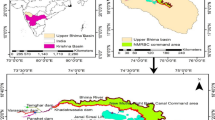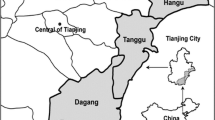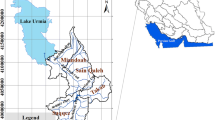Abstract
A Multiobjective Intuitionistic Fuzzy Linear Programming model is developed to get an optimal cropping pattern in the command area of the Ukai-Kakrapar Irrigation project in Gujarat, India. Four conflicting objectives, namely, maximization of net irrigation benefits (NIB), maximization of employment (EG), minimization of cultivation cost (CC), and maximization of revenue generation on account of industrial and municipal supplies (MI) were optimized for their crisp linear programming (LP) solutions. Intuitionistic Fuzzy Optimization Multi-objective fuzzy linear programming (IFO MOFLP), IFO MOFLP with hesitation index, and two-phase IFO MOFLP models were developed from their LP solutions. The TPIFO MOFLP model has been found to perform better than other variant of IFO MOFLP models and the MOFLP model (Average operator Case-I) developed by Mirajkar and Patel in J Water Resour Plan Manag 142(11):1–16, 2016 for the same command area with reference to the uncertainty parameters like degree of acceptance (α), rejection (β), and hesitation index (π) for 75% dependable inflow condition. The recommended TPIFO MOFLP model also gives higher irrigation intensity (112.19%) than Average Operator Case-I (104.60%) for the whole command area. The implementation of TPIFO MOFLP model in the command area is likely to give the values of NIB, EG, CC, and MI as Rs 10,836.19 million, 34,980.4 thousand workdays, Rs 5,672.23 million, and Rs 2,314.03 million, respectively, with α = 0.68, β = 0.19, and π = 0.13. The suggested model with new parameters like α, β, and, π, would assist the decision makers to apply the same on real world problems with greater certainty.





Similar content being viewed by others
Data Availability
The corresponding author has access to all the data, models, or algorithms used in current investigation. The data used can be released to the public platform only after getting permissions from the relevant data providing agencies.
References
Atanassov KT (1986) Intuitionistic fuzzy sets. Fuzzy Sets Syst 20(1):87–96. https://doi.org/10.1016/S0165-0114(86)80034-3
Angelov PP (1997) Optimization in an Intuitionistic fuzzy environment. Fuzzy Sets Syst 86(3):299–306. https://doi.org/10.1016/S0165-0114(96)00009-7
Arunkumar R, Jothiprakash V (2016) A Multi-objective fuzzy linear programming model for sustainable integrated operation of a multireservoir system. Lakes Reserv Res Manag 21(3):171–187. https://doi.org/10.1111/lre.12136
Bharati SK, Singh SR (2014) Solving multi objective linear programming problems using intuitionistic fuzzy optimization method: A comparative study. Int J Model Optim 4(1):10–16. https://doi.org/10.7763/ijmo.2014.v4.339
Chaudhari SA, Anand Raj P (2010) Multi-objective multireservoir operation in fuzzy environment. Water Resour Manag 24(10):2057–2073. https://doi.org/10.1007/s11269-009-9538-7
Garai AG, Roy TK (2013) Intuitionistic fuzzy optimization: Usage of hesitation index. Int J Comput Technol 19(4):60–68. https://doi.org/10.24297/ijct.v10i4.3248
Hernandez EA, Uddameri V (2010) Selecting agricultural best management practices for water conservation and quality improvements using Atanassov’s intuitionistic fuzzy sets. Water Resour Manag 24(15):4589–4612. https://doi.org/10.1007/s11269-010-9681-1
Hashemi H, Bazargan J, Monsavi S (2013) A Compromise ration method with an application water resources management: An Intuitionistic fuzzy set. Water Resour Manag 27(7):2029–2051. https://doi.org/10.1007/s11269-013-0271-x
Jafarian E, Razmi J, Baki MF (2018) A flexible programming approach based on intuitionistic fuzzy optimization and geometric programming for solving multi-objective nonlinear programming for solving multi-objective nonlinear programming problems. Expert Syst Appl Int J 93:245–256. https://doi.org/10.1016/j.eswa.2017.10.030
Li M, Fu Q, Singh VP, Ma M, Liu X (2017) An intuitionistic fuzzy multi-objective non-linear programming model for sustainable irrigation water allocation under the combination of dry and wet conditions. J Hydrol 555:80–94. https://doi.org/10.1016/j.jhydrol.2017.09.055
Mirajkar AB, Patel PL (2016) Multi-objective two-phase fuzzy optimization approaches in management of water resources. J Water Resour Plan Manag 142(11):1–16. https://doi.org/10.1061/(ASCE)WR.1943-5452.0000682
Morankar DV, Srinivasa Raju K, Nagesh Kumar D (2013) Integrated sustainable irrigation planning with multi-objective fuzzy optimization approach. Water Resour Manag Springer 27(11):3981–4004. https://doi.org/10.1007/s11269-013-0391-3
Pawar SV, Patel PL, Mirajkar AB (2022a) Intuitionistic fuzzy approach in multi-objective optimization for KRBMC irrigation system. India. ISH J Hydraul Eng 28(1):463–470. https://doi.org/10.1080/09715010.2020.1781700
Pawar SV, Patel PL, Mirajkar AB (2022b) Intuitionistic fuzzy optimization approach in optimal irrigation planning of Ukai-Kakrapar irrigation project. ISH J Hydraul Eng Published Online, India. https://doi.org/10.1080/09715010.2022.2052988
Raju KS, Kumar ND (2000) Irrigation planning of sri ram sagar project using multi objective fuzzy linear programming. ISH J Hydraul Eng 6(1):55–63. https://doi.org/10.1080/09715010.2000.10514665
Raju KS, Vasan A, Gupta P, Ganesan K, Mathur H (2012) Multi-objective differential evolution application to irrigation planning. ISH J Hydraul Eng 18(1):54–64. https://doi.org/10.1080/09715010.2012.662428
Regulwar DG, Gurav JB (2010) Fuzzy approach based management model for irrigation planning. J Water Resour Prot 2(6):545–554. https://doi.org/10.4236/jwarp.2010.26062
Regulwar DG, Gurav JB (2012) Sustainable irrigation planning with imprecise parameters under fuzzy environment. Water Resour Manag 26(13):3871–3892. https://doi.org/10.1007/s11269-012-0109-y
Ren C, Guo P, Tan Q, Zhang L (2017) A Multi-objective fuzzy programming model for optimal use of irrigation water and land resources under uncertainty in Gansu Province, China. J Clean Prod 164:85–94. https://doi.org/10.1016/j.jclepro.2017.06.185
Sahoo B, Lohani AK, Sahu RK (2006) Fuzzy Multi-objective and linear programming-based management models for optimal land-water-crop system planning. Water Resour Manag 20:931–948. https://doi.org/10.1007/s11269-005-9015-x
Acknowledgements
The Centre of Excellence (CoE) on Water Resources and Flood Management, established under the TEQIP II grant of the Ministry of Human Resource Development, Government of India, is gratefully acknowledged by the authors for providing the necessary computational facility in analyzing the data of current investigation. The Surat Irrigation Circle (SIC), Kakrapar Irrigation Division, Surat, Gujarat, India, are also thankfully acknowledged by the authors for supplying the data required for analysis in the current work.
Author information
Authors and Affiliations
Contributions
Conceptualization- Sangita V. Pawar, Prem Lal Patel, Ashwini B. Mirajkar; Data curation- Ashwini B. Mirajkar, Prem Lal Patel; Formal analysis- Sangita V. Pawar and Ashwini B. Mirajkar; Project administration- Sangita V. Pawar, Prem Lal Patel, Ashwini B. Mirajkar; Software- Sangita V. Pawar and Ashwini B. Mirajkar; Supervision and Validation- Sangita V. Pawar, Prem Lal. Patel, Ashwini B. Mirajkar; Writing-original draft- Sangita V. Pawar, Writing-review and editing- Sangita V. Pawar, Prem Lal Patel, Ashwini B. Mirajkar.
Corresponding author
Ethics declarations
Ethical Approval
N.A.
Consent to Participate
All authors have consented to participate in the publication process.
Consent to Publish
All authors agree to publish this manuscript.
Competing Interests
The authors have no relevant financial or non-financial interests for disclosure.
Additional information
Publisher's Note
Springer Nature remains neutral with regard to jurisdictional claims in published maps and institutional affiliations.
Supplementary Information
Below is the link to the electronic supplementary material.
Rights and permissions
Springer Nature or its licensor (e.g. a society or other partner) holds exclusive rights to this article under a publishing agreement with the author(s) or other rightsholder(s); author self-archiving of the accepted manuscript version of this article is solely governed by the terms of such publishing agreement and applicable law.
About this article
Cite this article
Pawar, S., Patel, P. & Mirajkar, A.B. Multiobjective Intuitionistic Fuzzy Optimization Approach in Optimal Irrigation Planning and Operation of Reservoir. Water Resour Manage 37, 1033–1053 (2023). https://doi.org/10.1007/s11269-022-03406-8
Received:
Accepted:
Published:
Issue Date:
DOI: https://doi.org/10.1007/s11269-022-03406-8




